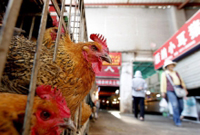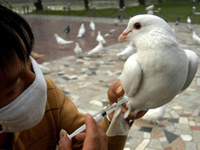A(H7N9) influenza borke out in China recently.
What is this A(H7N9) virus?
| | H7N9 is a subtype of influenza virus. H7N9 viruses have been previously detected mainly in wild birds, though other H7 viruses been reported around the globe in domestic and wild birds. The recent event in China represents the first ever report of H7N9 virus in humans. Unlike other influenza strains, including highly pathogenic avian influenza H5N1, this new virus is hard to detect because the novel virus causes little to no signs of disease in animals. H5N1, where chickens were dying off on a large scale, with this virus we don't have a red flag that immediately signals an infection. This means farmers may not be aware that virus is circulating in their flock. |
What are the main symptoms of human infection with influenza A(H7N9) virus?
| | According to World Health Organization, symptoms include fever, cough, and shortness of breath, which progressed to severe pneumonia.WHO also notes that information is limited. Thus far, patients with this infection have had severe pneumonia. However, information is still limited about the full spectrum of clinical signs due to infection with influenza A(H7N9) virus. |
With the virus harder to detect, good biosecurity measures become even more essential to reducing the risk of virus transmission to humans and animals. Good biosecurity and hygiene measures implemented by farmers, livestock producers, transporters, market workers and consumers represent the first and most effective way to protect the food chain.
How is this A(H7N9) virus associated with animals?
| | Chinese authorities have officially reported their detection of this H7N9 virus in bird samples collected from chickens, quails and pigeons at live bird markets in areas where humans have been affected. The only previous reports of infections with this virus in Asia in animals come from 2008 events in the Republic of Korea and Mongolia where H7N9 subtype was isolated from wild birds. |
It is important to note that H7 viruses and their subtypes (e.g. H7N2, H7N6, and H7N7) have been identified in poultry all over the world.
What is the source of the A(H7N9) virus that is infecting humans?
| | The source of infection has not yet been confirmed. A number of the human H7N9 cases in China have reportedly had contact with domestic poultry. The Chinese authorities are conducting an extensive surveillance programme in domestic livestock in provinces where human cases have been found to gather further information. The genetic analysis of the viruses isolated show components that are avian in origin, but the precise source has yet to be determined. |
While this new virus is being evaluated, Chinese authorities continues to recommend the following standard precautions:
| | ♦Keep all birds and livestock separate from people's living areas. Keep wild birds away from poultry and other animals, keep different types of bird and species of animal apart. ♦Report sick or dead animals to the local veterinary (or public health) authorities ♦Wash your hands often to kill and remove the virus ♦Eat well-cooked meat products. Do not eat sick or dead animals and do not give or sell them to others ♦Seek immediate advice from your doctor if you show signs of fever after being in contact with poultry, farmed birds, wild birds or other animals. ♦If the human threat is confirmed as animal in origin, culling would be appropriate as long as it is performed in a humane way with appropriate compensation made. |
Written by Nicolas Yang










